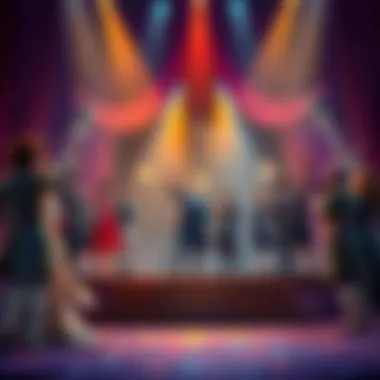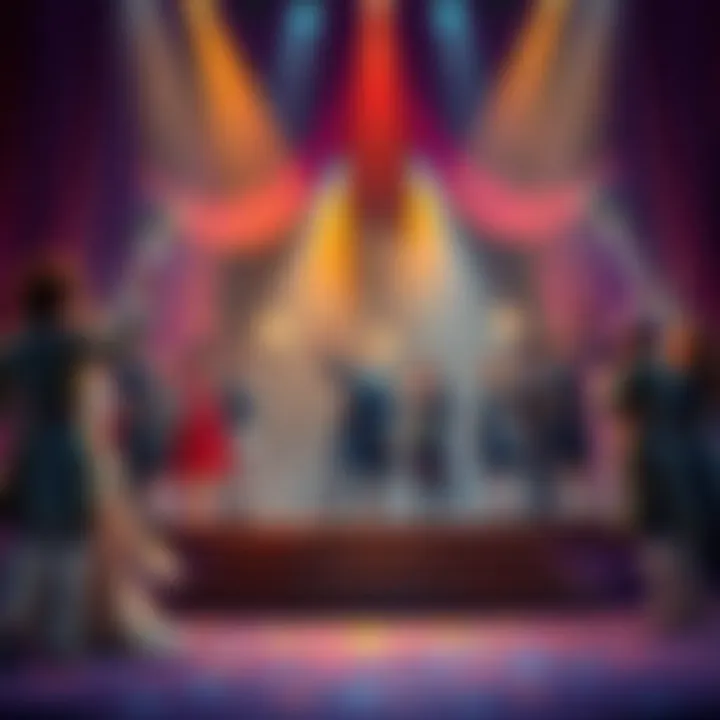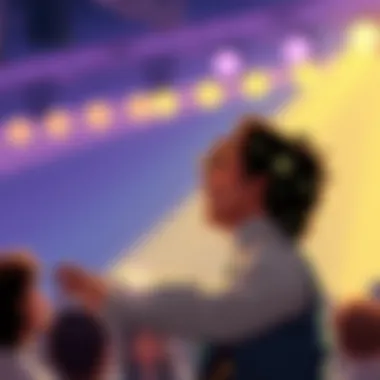An In-Depth Look at Hamilton: The Musical


Intro
In the realm of contemporary musical theater, Hamilton stands as a monumental beacon, captivating audiences with its unique blend of storytelling and innovative music. The show, which tells the life story of Alexander Hamilton, intertwines history with modern hip-hop, R&B, and traditional show tunes. This fusion not only redefines the musical genre but also forces us to reevaluate historical narratives in a more inclusive and nuanced light.
Created by Lin-Manuel Miranda, Hamilton isn't just a story about one man; it's a reflection of America's ongoing dialogue about race, identity, and representation. As we delve into the multiple dimensions of this production, we will explore how its elements resonate deeply with both historical context and contemporary societal issues. Each character, each song, and each performance adds to the intricate tapestry of narratives that the musical weaves, making it a complex yet relatable production for a wide range of audiences.
This analysis aims to unpack the layers of Hamilton, covering its historical significance, thematic depth, and cultural impact. Through this lens, we will uncover key characters and notable performances, giving insight into how the show merges various musical styles to create a lasting influence on modern theater.
Foreword to Hamilton
When it comes to modern theater, few productions have made a splash quite like Hamilton. This musical, crafted by Lin-Manuel Miranda, takes a deep dive into the life of Alexander Hamilton, one of the founding fathers of the United States. However, it doesn’t just recount historical events; it also tackles themes that resonate with contemporary audiences, from ambition to legacy.
The introduction of Hamilton into the theatrical landscape has changed how stories are told, particularly historical narratives. By employing a diverse cast and blending various musical styles, the production not only depicts historical figures but does so through a modern lens. This section will pave the way for a thorough exploration of its cultural significance and artistic merit.
Overview of the Musical
Hamilton first graced the stage in 2015, quickly earning critical acclaim for its innovative approach. The musical draws on hip-hop, R&B, and traditional show tunes, creating a fresh sound that captivates listeners of all ages. The narrative unfolds through the eyes of Hamilton himself, illustrating his rise from an impoverished immigrant to a prominent political figure. The clever incorporation of historical details lends an authentic backdrop, while the pulsating rhythms and dynamic choreography keep audiences engaged.
In addition to its musical elements, the show is unique in its casting decisions. By assembling a racially diverse cast to portray historical figures, Hamilton illuminates the relevance of these stories in modern society, prompting audiences to reflect on issues of race, identity, and representation.
Significance in Contemporary Theater
The impact of Hamilton on contemporary theater cannot be overstated. It has stirred conversations about inclusion and representation, challenging traditional casting norms. This shift is not merely cosmetic; it encourages a broader range of voices to share their stories, promoting diversity in the arts.
Moreover, Hamilton infused mainstream culture with an awareness of American history through its catchy lyrics and memorable melodies. It has sparked interest in historical and civic education, with numerous schools using the musical as a teaching tool. Its blend of entertainment and education exemplifies how theater can be both informative and engaging.
In many ways, Hamilton stands at the crossroads of art and activism, making it a landmark work that reshapes audience expectations and artist ambitions alike. Those who encounter this musical often leave with a renewed interest in the past, making it much more than just another show in the theater circuit.
Historical Context
Understanding the historical context of "Hamilton: The Musical" is crucial as it lays the groundwork for the entire narrative and emotional weight of the production. This framing allows audiences to appreciate not just the events being portrayed but also the characters’ motivations, their aspirations, and their struggles. Without this historical backdrop, the musical risks becoming a mere collection of catchy tunes and impressive choreography rather than a vibrant retelling of a pivotal moment in American history.
The Life of Alexander Hamilton
Alexander Hamilton was born on January 11, 1755, in Charlestown, the capital of the Caribbean island of Saint Kitts and Nevis. His early life was marked by hardship. Orphaned at a young age, Hamilton’s resilience and intelligence became apparent as he overcame obstacles to educate himself. This drive ultimately led him to America, where he would become a Founding Father.
Hamilton's life is best described as a whirlwind of ambition and intellect. He served as George Washington’s aide-de-camp during the Revolutionary War, where he penned important correspondence and developed a close relationship with the leader. After the war, Hamilton’s role shifted towards governance and economics. He served as the first Secretary of the Treasury, where he laid the foundations of the American financial system. His vision, particularly his advocacy for a strong central government and a national bank, often put him at odds with other key figures like Thomas Jefferson.
This struggle between Hamilton and his political rivals showcases not just a conflict of personalities but also of visions for America's future—one where a strong centralized authority could aid in the development of the nation, versus the belief in agrarianism and states' rights. Hamilton's life, riddled with contradictions, ambition, and tragedy, sets the stage for a tale of perseverance against the odds, making his character one of the most compelling arcs in the musical.
The American Revolution Era
The American Revolution was not merely a war; it was the crucible that forged the identity of a nation. Beginning in the 1770s and culminating in 1783, the Revolution saw the thirteen colonies rise against British rule, fueled by desires for liberty, representation, and self-determination. This period of upheaval and change is the backdrop to Hamilton's story, illustrating how it was a breeding ground for ideas that would eventually shape modern democracy.
The era was characterized by fierce debates over governance, rights, and freedom. The conflicts between Loyalists and Patriots, the various battles fought, and the alliances formed (like that with France) were pivotal in the Americans' quest for independence. Events like the Boston Tea Party and the Continental Congress became rallying points for revolutionaries, who saw independence not just as a right, but as a necessity.


In terms of cultural significance, the American Revolution was also a melting pot of ideas. Enlightenment thinkers such as John Locke and Montesquieu heavily influenced the Founding Fathers, provoking discussions on liberty, justice, and the social contract. This intellectual ferment provided the environment for characters in the musical, such as Hamilton and Jefferson, to rise and advocate for radically different visions of what America could be.
“A nation is only as good as its people; it’s the heart that beats in its chest.”
Key Characters
Characters in Hamilton are not merely there for the plot; they serve as the very heartbeat of the musical, each contributing uniquely to its narrative and thematic depth. Understanding these key figures is essential for grasping the broader strokes of the story, which is a tale about ambition, resilience, and the forging of a nation. Each character carries luggage from their past, intertwining personal desires with the collective struggles of their time, making the musical resonate profoundly with contemporary audiences. Here, we will explore the significance of four pivotal characters: Alexander Hamilton, Aaron Burr, Eliza Schuyler Hamilton, and George Washington.
Alexander Hamilton
Alexander Hamilton, the show’s central character, embodies the very tenacity that drives the narrative forward. His journey from poverty in the Caribbean to becoming one of America’s founding fathers showcases his ambition and intellect. Hamilton’s financial policies and vision for a strong central government were instrumental in shaping the future of the nation, yet this influence came at a steep personal cost. His complex personality is portrayed with a mix of brilliance and desperation. Hamilton’s relentless push for recognition and respect reflects a universal struggle many face in their own lives.
His character serves as both a mirror and a contrast to the ideals of his contemporaries. The portrayal of Hamilton is vivid and dynamic; it invites audiences to reflect on themes of legacy and struggle for relevance in the sprawling history of America. This connection compels a deeper inquiry into what it means to be remembered in the annals of time.
"I am not throwing away my shot!" - A phrase that echoes Hamilton's relentless drive to seize opportunities, a mantra for those daring to chase their dreams.
Aaron Burr
Aaron Burr, portrayed as the antithesis of Hamilton, captivates through his blend of charm and caution. His character offers a poignant exploration of ambition that plays out in stark contrasts against Hamilton's aggressive pursuit. Burr’s famous line, “I’m a little more than the average guy,” resonates because it encapsulates his cautious, yet hopeful, desire for power and recognition. He is characterized by a strategic mind that ultimately leads him to a crossroads; his indecisiveness is his Achilles' heel, culminating in tragic choices that leave an indelible mark on his life.
The tension between Hamilton and Burr raises questions about the nature of ambition—whether being prudent is more advantageous than being audacious. The character of Burr illustrates that sometimes, standing still in ambition can lead to a life of regret rather than fulfillment.
Eliza Schuyler Hamilton
Eliza Schuyler Hamilton stands as a pivotal force behind the man who immortalized her. Her character shines a light on the often-overlooked contributions of women in history. Eliza's unwavering support for Hamilton is matched only by her resilience in facing personal challenges, particularly after his untimely death. Her emotional depth and strength illustrate the profound implications of love and loss, leading audiences to question the effects of personal sacrifice for the public good.
Eliza’s transformation from a loving wife to a determined widow who fights to preserve Hamilton’s legacy encapsulates a narrative of empowerment amid patriarchal constraints. This transition invites reflections on the power of memory and the roles of women who often remain in the shadows of their accomplished spouses.
George Washington
George Washington is the stalwart figure of American independence and leadership, represented not just as a president but as a mentor to Hamilton. His character provides a moral compass and a guiding influence throughout the narrative. Washington’s wisdom often challenges Hamilton’s youthful boldness and ambition, creating a dynamic interplay that emphasizes leadership's weight and complexities.
Washington’s commitment to unity amidst division serves as a contrast to the ambition-driven conflicts that characterize much of the storyline. His refrain about “the American experiment” embodies the fragile state of the young republic, presenting themes of duty and sacrifice that echo throughout the musical. Washington's choice to step away from power demonstrates the selflessness that is occasionally overshadowed by personal aspirations, leaving a legacy that resonates far beyond his presidency.
By exploring these characters, Hamilton not only captures historical narratives but also personalizes them, inviting audiences to connect with emotions and struggles that are timeless. Each character operates within a rich tapestry of themes, suggesting a vast landscape for exploration in both personal and historical contexts.
Musical Styles and Composition
The musical landscape of Hamilton represents an innovative blend that redefines the boundaries of traditional theater. The composition intertwines various musical styles to create a rich tapestry that not only highlights the narrative but also enhances emotional resonance. By exploring its eclectic style, we can better understand the profound impact Hamilton has had on contemporary musicals.
Blend of Genres
Hamilton operates in a genre-blending space that marries hip-hop, R&B, pop, and traditional show tunes. This fusion sets it apart from many predecessors and currents in theater. From the outset, one can identify hip-hop's rhythmic delivery melding seamlessly with melodic pop lines, creating a dynamic experience. The incorporation of R&B influences offers a fresh perspective that appeals to a broad demographic, enhancing its reach far beyond the stage.
Elements of traditional Broadway also persist, yet they evolve through the lens of contemporary music. Take, for instance, how the song "My Shot" mirrors both the urgency of Hamilton's ambition and the cadence of modern rap. This multi-genre approach is deliberate, reflecting the multi-faceted nature of the American experience, thus allowing for deeper connections among diverse audiences.


Influence of Hip-Hop
Hip-hop serves as the backbone of Hamilton, sparking conversations around race and representation in theatrical realms. The vibrant beats and lyrical intricacies allow for complex storytelling. The infusion of rap is not just in rhythm, but also in how it carries history. For example, Hamilton's rapid-fire verses echo the oral traditions prevalent in African-American history, with accounts conjured through rhythm and flow.
Moreover, the hip-hop prominence draws parallels between the struggles of early American revolutionaries and the battles modern-day artists face in the music industry. This layering enhances the understanding of Hamilton's timeless quest for legacy, offering a reflective mirror on systemic issues still present today.
Lyricism and Storytelling
The lyrics in Hamilton are crafted with precision, functioning as both narrative and poetic device. Lin-Manuel Miranda's writing showcases a masterclass in storytelling through lyrics. Every phrase is intentional, weaving historical facts into engaging narratives. For example, the interplay between Hamilton's ambition and Burr's cautious disposition is portrayed exquisitely through their lyrical exchanges, exemplifying the art of character development via musical dialogue.
Furthermore, mirroring the rhythm with the intensity of the storyline paces the audience's emotional investment. Consider the use of motifs, where recurring lines or themes deepen connections throughout the show. As characters face their respective trials, the music elevates these moments, allowing audiences to feel their triumphs and failures intimately. This synergy between lyrics and music fundamentally enriches the storytelling, reinforcing the dramatic arcs of each character and their intertwined fates.
As audiences absorb the complexities layered within Hamilton, the bold musical choices enhance its narrative depth. The composition is not merely an accessory but a vital character in its own right, deserving of exploration in its own context.
Thematic Elements
In examining Hamilton, one must peel back the layers to uncover the thematic elements woven into its narrative fabric. These themes are not merely embellishments; they are the bedrock that supports the characters' motivations and the overall message of the musical. The exploration of these elements provides valuable insight into the cultural resonance of the story today.
Legacy and Memory
The theme of legacy permeates Alexander Hamilton's life and work throughout the musical. As a key architect of American democracy, Hamilton’s pursuit of a lasting impact drives many of his actions. He often reflects on his limited time and the urgent desire to secure a place in history. For instance, in the song "My Shot," Hamilton embodies the ambition to break free from obscurity and make a mark. This narrative resonates profoundly with audiences today, encouraging reflections on their own desires for significance. In addition, the use of historical events, such as the formation of the nation, prompts the viewer to consider how individuals and their actions are recorded and remembered. What remains once we are gone? This contemplation fosters an enduring dialogue on the responsibility of creating and preserving one's legacy.
Ambition and Public Life
Ambition serves as both a double-edged sword and a driving force within Hamilton. The characters are steeped in aspirations that propel them into the public sphere, but they soon find that the pursuit of power can come at a personal cost. Alexander Hamilton himself demonstrates relentless drive, fueled by the belief that ambition can lead to reform and progress. However, as the narrative unfolds, we witness the toll that this ambition takes on relationships and ethical standing. The rivalry with Aaron Burr exemplifies this tension; Burr's more measured approach to ambition contrasts sharply with Hamilton’s unapologetic fervor. This aspect of the musical makes audiences question the ethics behind political aspiration and how far one might go to achieve greatness. The struggle for influence and recognition reflects society's ongoing discourse about public service versus personal interest, and the boundaries we often blur in pursuit of both.
Fame and Its Consequences
Fame in Hamilton serves as a cautionary tale about the bright lights and dark shadows of public recognition. While achieving fame can afford individuals a platform, it inevitably brings challenges that one might not foresee. Throughout the show, Hamilton's rising prominence leads to scrutiny and conflict; his decisions are placed under a microscope, illustrating the vulnerabilities that accompany public life.
The darker aspects of fame are most poignantly illustrated in Hamilton's contentious interactions, where the spotlight magnifies every misstep. Here, the contrast between Hamilton’s vibrant charisma and his eventual downfalls paints a complex picture of public life. One might ponder whether it’s the applause or the critique that shapes their identity most profoundly. In a world increasingly obsessed with fame, Hamilton's journey prompts us to question the true cost associated with public acclaim and whether the chase for it is worth the potential downsides.
"I’m not throwing away my shot!"
This line becomes lamentation as much as aspiration, highlighting the transient nature of opportunities in the sweeping saga of life.
These thematic elements coalesce to deepen the audience's engagement with Hamilton, offering more than mere historical retelling. They invoke discussions on legacy, ambition, and the burdens of fame which resonate universally across varied social landscapes today.
For further understanding and exploration of Hamilton, the musical's detailed history can be found on Wikipedia, and discussions regarding its cultural implications are active on platforms like Reddit.
Cultural Impact
The cultural impact of Hamilton: The Musical extends far beyond its staging and performance; it has etched itself into the very fabric of contemporary society. Understanding this impact offers a glimpse into how art can influence public perception and dialogue surrounding history and identity.
Reception and Critiques
When Hamilton hit the Broadway stage, it was like a bolt of lightning. Audiences packed theaters, eager to immerse themselves in a show where the historical narrative of America’s founding was told through the lens of hip-hop and R&B. Critics hailed it as revolutionary not just for its music but also for its casting choices. The decision to prominently feature actors of color in roles typically reserved for white historical figures sparked significant discussions about representation in theater and broader cultural contexts. Yet, not all feedback was glowing. Some critics argued that the musical glossed over the messy realities of America's founding, presenting a sanitized version that could erode the complex narratives of race and class within American history.


"There's a fine line between education and entertainment, and while Hamilton does one very well, the other sometimes takes a back seat."
Influence on Modern Musicals
In the world of musical theater, Hamilton is a game changer. It has rejuvenated the genre by blending modern musical styles with classic theatrical elements. The success of Hamilton has sparked a wave of new productions aiming to fuse different genres, appealing to younger audiences who may not have felt connected to conventional musical formats. Shows like Dear Evan Hansen and Six owe a nod of appreciation to Lin-Manuel Miranda’s work, which demonstrated that musicals could be both relatable and artistic. These influences underscore a broader trend where history is reimagined through diverse cultural lenses, inviting a re-examination of stories traditionally told in a more rigid format.
Educational Value
Beyond the stage, Hamilton has emerged as an educational tool with profound implications. Schools and educational programs have adopted it as a resource to spark interest in American history. The musical encourages students to engage with historical texts, using modern vernacular that resonates with younger generations. Curated lesson plans often include assignments that require students to write their own raps or songs about historical events, facilitating active engagement with the content. Moreover, the availability of the Hamilton soundtrack and its performances on platforms like Disney+ have made it accessible to wider audiences than ever before, promoting a culture of learning that extends beyond traditional classroom walls. Topics intertwining history and the arts have found new life, inspiring educators to cultivate an environment where interdisciplinary learning thrives.
In summary, the cultural impact of Hamilton: The Musical is monumental, reshaping conversations about representation, re-defining the landscape of modern musicals, and enhancing educational discourse. It serves as a reminder of the power that creative expression holds in capturing the imagination and promoting meaningful dialogue among diverse communities.
Production Elements
The production elements of Hamilton play a crucial role in shaping the storytelling and overall experience of the musical. By combining thoughtful direction, innovative choreography, and striking set and costume design, the creators have transformed a historical narrative into a vibrant theatrical event that captivates audiences around the world.
Direction and Choreography
The direction of Hamilton, led by Lin-Manuel Miranda and Thomas Kail, is integral to its success. The artistic choices made in this realm not only guide the performance but also define its pacing and emotional resonance. Each scene is meticulously crafted; the dynamic movement of characters across the stage emphasizes the urgency and intensity of the political climate in which Alexander Hamilton operated. Director Thomas Kail's ability to juggle multiple plotlines is impressive. He leaves space for moments of silence, letting the weight of a phrase linger in the air. This helps viewers soak in the gravity of Hamilton's contributions and the conflicts erupting around him.
Choreography plays its part in this compelling tableau. The choreography, helmed by Andy Blankenbuehler, is a blend of varied styles, including hip-hop, salsa, jazz, and even traditional Broadway. These styles are woven seamlessly into the storytelling, allowing characters to express their emotional states through movement as much as through lyrics. The choreography reflects the chaos of revolution—layers of bodies in motion, symbolizing the many forces at play during America's fight for independence. Each dance sequence not only serves to entertain but to enhance the narrative, making the revolutionary spirit palpable.
Set and Costume Design
Set and costume design are essential in establishing the historical setting and context of Hamilton. The stage, designed by David Korins, utilizes a simple yet effective backdrop of scaffolding. This choice allows for a flexible performance space, adapting to various scenes that range from grand political debates to intimate personal moments. The set's simplicity emphasizes the actors and their performances; it does not overshadow but instead complements the rich storytelling.
Costumes, designed by Paul Tazewell, further bridge the gap between the 18th century and contemporary audiences. The clothing is carefully curated to reflect the period while also hinting at characters’ personalities. For instance, Hamilton's attire often contrasts with the other characters, visually reinforcing his ambitions and drive for success. Colors and fabrics communicate status and character, drawing attention to the complexities of life during the early days of America.
"The power of Hamilton lies not just in its music and lyrics, but in how every aspect of production contributes to the overall narrative."
The production elements of Hamilton are a testament to the artistry and innovation present in contemporary theater. They ensure that while the story is rooted in history, it speaks to the modern audience in ways that are immediately engaging and thought-provoking. This synergy between direction, choreography, set and costume design elevates the musical, transforming it into a cultural phenomenon that resonates across generations.
The End
The conclusion of this analysis serves as a critical lens through which we can reflect on the intricate layers of meaning embedded within Hamilton: The Musical. It is not simply a summation of what we have learned about the show but an opportunity to delve deeper into its significance in both a historical and contemporary context.
Reflections on Impact
Hamilton has done more than just entertain; it has sparked discussions, altering the landscape for present-day theatre. The story of Alexander Hamilton, once a mere footnote in the annals of American history, has been revitalized and presented in a way that resonates with the modern audience. This is especially pertinent in today's socio-political climate, where themes of ambition and legacy converge with issues of racial identity and representation. The diverse casting choices, coupled with a music style that's rooted in hip-hop, have ushered in a renaissance of historical narratives, making history accessible and engaging to a wider spectrum of people.
By incorporating the struggles and aspirations of figures from the past with today’s realities, Hamilton has indirectly provided a platform for dialogue on identity, power, and history. This unique fusion is not only refreshing but also serves the essential purpose of connecting generations, allowing audiences to confront the legacies that shape their present and future.
"The story takes on new dimensions when viewed through the lens of contemporary issues, reminding us that the past is ever-present and relevant."
Future of Historical Musicals
Looking ahead, the impact of Hamilton is likely to resonate for years to come, shaping the future of the historical musical genre. Other productions will undoubtedly benchmark themselves against its success, aiming to blend educational content with entertainment value. This trend may lead to a surge in works that tackle overlooked historical figures or events, nurturing a sense of cultural appreciation and dialogue.
Educational institutions may adopt this model, utilizing musical theatre as a medium for engagement in subjects like history, politics, and even social studies. This could spark further interest in niche subjects, drawing young minds to investigate their cultural heritage.
While the fusion of modern music styles with historical storytelling invites new interpretations, it also poses challenges regarding authenticity and historical accuracy. Future creators will have to navigate these waters carefully, ensuring that compelling narratives remain rooted in solid historical foundation, while simultaneously challenging existing narratives.
In summary, as we come to the end of our exploration of Hamilton, it is clear that the musical stands as a monumental piece in the theatre landscape. Its reflections on impact and future possibilities paint an optimistic picture for both audiences and creators alike, signifying that the heart of storytelling—whether it be historical or modern—will continue to thrive.















